What exactly is sRGB Emulation Mode, and why is it important?
Where do you spend the most of your searching time? If you're a gamer or content creator, it's probably not a gorgeous horizon or a lovely piece of art, but your computer monitor. And when it comes to monitors, we can't stop talking about sRGB emulation mode.
You may be wondering what sRGB emulation mode is and why it is crucial. I'm glad you asked. The sRGB mode improves the colour accuracy of the material on the monitor. As a result, you get a much better sense of what you're looking at.
Yes, we understand that such a straightforward response is insufficient to satisfy your curiosity. So join us as we go over the ins and outs of sRGB emulation mode.
What is the sRGB Emulation Mode, exactly?
You've probably heard of RGB, but what the heck is this sRGB thing? Is it a palatable version of RGB? I'm sorry to tell you that it isn't.
It is simply an 8bit colour space that is extensively utilised in non-HDR content. However, do not confuse it with colour spaces with a greater gamut. It is, in fact, the normal one.
The most accurate colour reproduction is provided by sRGB mode. It's a lifesaver when you try to be a colour expert and wind up ruining everything. This mode prevents you from modifying the colour parameters.
This setting is especially useful when working on Adobe colour space monitors. sRGB was configured in some monitors to display pleasantly oversaturated content.
And this is where sRGB emulation mode can be a game changer in terms of providing the most accurate colours.
What Distinguishes SRGB from RGB?
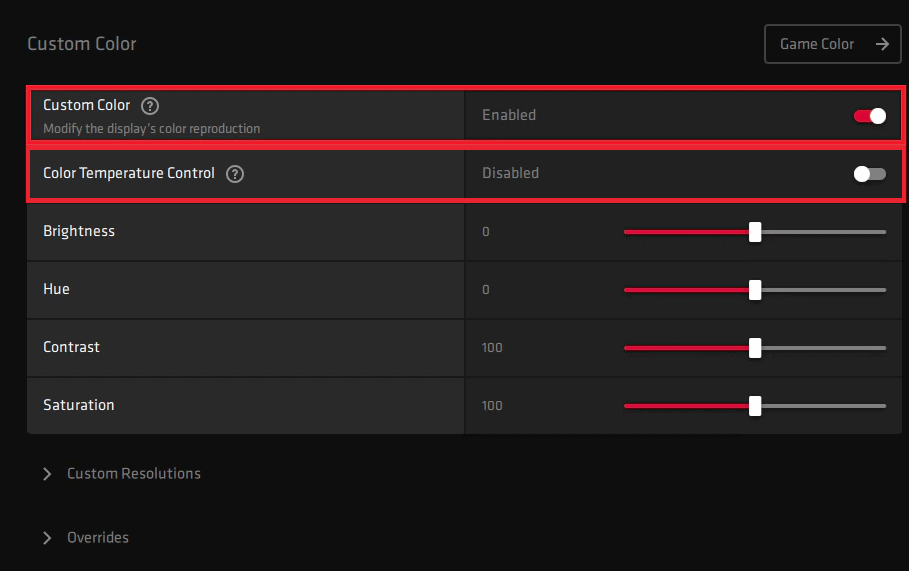
The ability of human eyes to produce visual images is unrivalled by any technological device produced thus far. Even if you have the most advanced camera, printer, or display, they are little when compared to our eyes.
These devices will not be able to replicate all colour gamuts with the same accuracy. That is why different displays, printers, and cameras produce varying colour reproduction. We have multiple colour spaces to deal with this, such as Adobe RGB and sRGB.
If you've already begun to think, wow! Because sRGB is such a broad colour space, chances are you've never been so wrong in your life. Only 35% of CIE colours can be covered by SRGB. It is, however, compatible with all types of monitors.
Adobe first introduced the RGB colour space in 1998, and they worked hard to match the sRGB colour palette. Was it, however, a wise decision? It was, without a doubt!
When printing with a high-quality colour printer, you can take advantage of this feature. Adobe RGB has covered about half of the CIE colour space. However, only a colour specialist would be able to tell the difference between Adobe RGB and sRGB mode.
So, what exactly distinguishes RGB from sRGB?
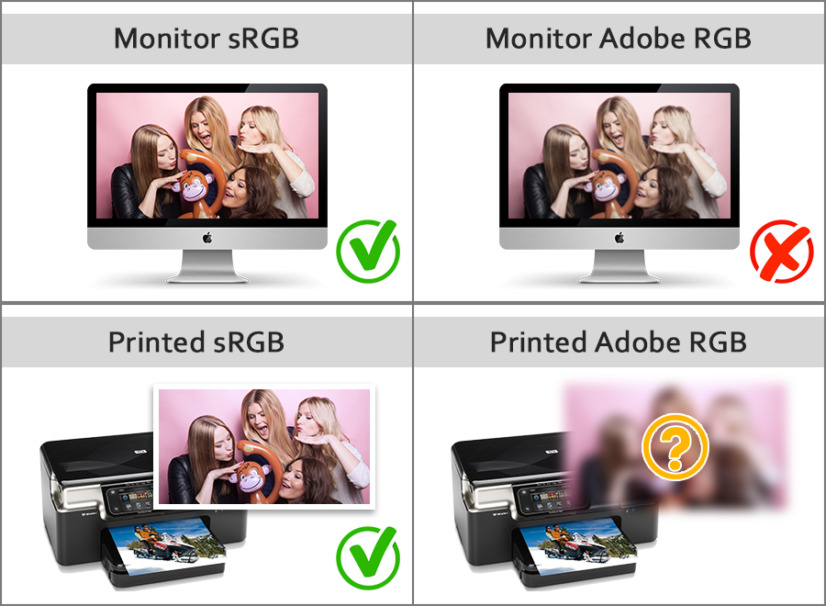
RGB colour refers to any colour that is produced and used in any technology or software.
sRGB, on the other hand, is a collection of colour standards produced by Microsoft and HP. It's a common and popular colour mode in today's electronic products, however it has a narrow colour spectrum.
So, what exactly is the colour gamut? Let's talk about it.
What Is Color Gamut, and Why Do You Need to Understand It?
You see distinct hues everywhere you look, don't you? These hues have distinct ranges, and every colour visible to your eyes is referred to as the gamut.
sRGB is a colour gamut as well. Almost every monitor you've ever used has undoubtedly had a sRGB colour gamut, which is why you need to understand how it works.
You may be asking why the sRGB colour gamut is so popular. That's an excellent question! The sRGB colour space, on the other hand, provides the fastest colour replication, providing a remarkably realistic experience on your monitor.
Things appear more vivid and colourful when seen on a monitor with a wide colour gamut. Some people may enjoy it, while others may not.
And this is where sRGB comes in to provide a one-of-a-kind viewing experience. It does, however, remove the ability to adjust your gamma setting and colour control.
How Do You Adjust the Monitor's Color Gamut?
The main issue that customers face when it comes to changing the gamut on their display is that certain manufacturers do not provide sRGB emulation mode.
And, of course, they have a compelling purpose to be here. Some consumers enjoy heightened colours and aren't concerned with how precise or realistic the colour seems.
Furthermore, sRGB emulation mode prevents adjusting the brightness of a monitor. As a result, many consumers may find it uncomfortable to operate their monitor with an unfavourable brightness level.
A few manufacturers allow you to adjust the brightness. However, they are powerless to prevent the gamma and colour channels from being locked.
If you are not a computer expert, it is best to use the monitor's OSD (On-screen display control) to alter the colours. Otherwise, if you do not use the appropriate procedure, you may end up damaging your entire colour viewing experience.
Remember that the graphics driver does not allow you to modify the brightness of the backlight. It can adjust the digital brightness, but not the backlight brightness. You must calibrate your display to achieve the best colour output.
Wide Range and Difficulties
Modern monitors have wide-gamut panels, which can be highly useful for presenting HDR content and games. It will not, however, be a buttery smooth experience for you. So, what's the deal?
Look, sweetheart, the majority of the stuff we encounter on various devices is based on sRGB standards. As a result, when viewing sRGB content on wide-gamut monitors, the colours will appear oversaturated, stretched, and unnatural.
If you like those pumped-up hues, it won't be an issue at all. To be honest, most users don't give a hoot about colour accuracy. They prefer the increased vividness.
However, if you enjoy photo and video processing, sRGB mode is your greatest friend. Skin tones may seem sun-burned and too red if sRGB emulation mode is not used. That is not something your clients would appreciate seeing. What you'll need here is a mechanism to see and deal with sRGB information without having to force the colour gamut.
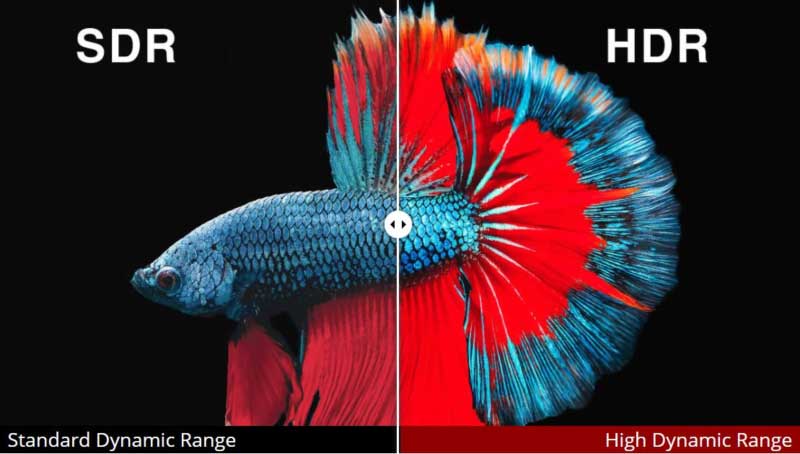
-P3 DCI
DCI p3 may be a common term if you work in cinematography editing. DCI is an abbreviation for Digital Cinema Initiatives, which is directly tied to movie and cinema material. You can't avoid discussing DCI p3 when it comes to HDR films, smart TVs, and monitors.
So, what distinguishes it from other monitors? Higher DCI p3 monitors may display a far wider range of colours than normal red, green, and blue monitors.
The majority of current games, HDR movies, and video content are excellent instances of DCI p3. To view the full spectrum of colours, you will need a DCI p3 compliant screen.
One issue to keep in mind is that many modern display makers will state that their monitor is DCI p3 compatible.
However, you must exercise caution in determining if it has 100 percent coverage capability or not. You won't obtain the best colour accuracy if you don't.
Why Is It Necessary to Calibrate Your Monitor?
Are you concerned about whether or not your monitor supports sRGB mode? Listen, most displays use the sRGB colour space to show material, so there's no need to worry.
However, if you want to give your eyes the greatest viewing experience possible, you must calibrate the display. Why? Let us investigate -
Viewing Situations
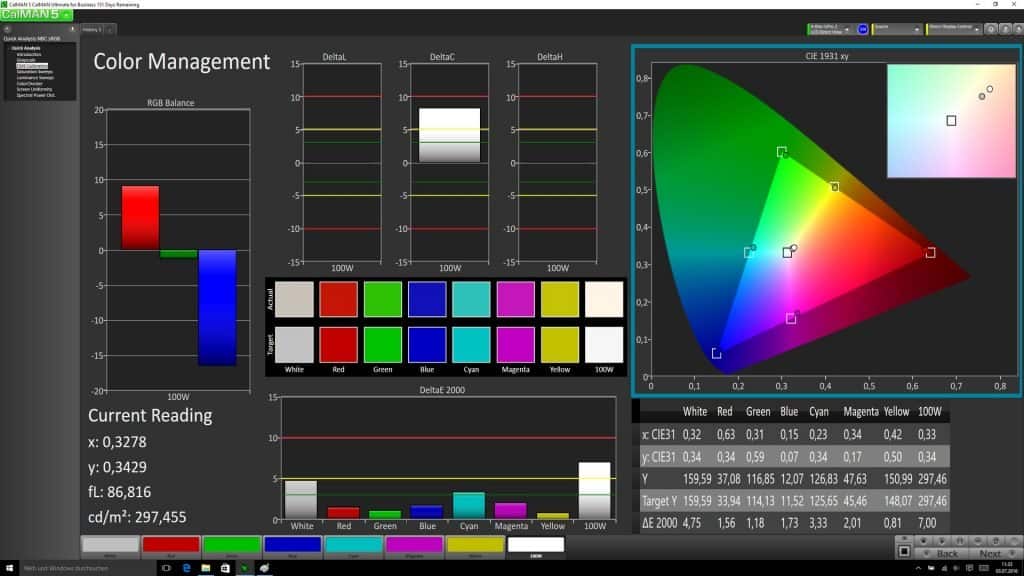
Look, whatever you see on the monitor is based on two factors. The first is what your monitor physically displays, and the second is the viewing condition.
When viewing the Adobe RGB monitor in a chilly lighting condition, the colour will appear slightly warmer than usual. Isn't that a nice thing?
Colors, on the other hand, will appear colder when viewed in warm lighting circumstances. But why is that? How will the manufacturer know in what condition you'll be using the monitor, dude? That's why they didn't include any global options.
Monitor and video card
Another difficulty is that the video card manufacturer has no idea what monitor you will use as the output for their card. For a better viewing experience, connect the graphics card signal to your monitor's colour settings.
If your monitor is not calibrated, you may also experience vexing problems such as poor video production and printing outcomes. No one wants to see those dreadful colours, after all.
How Do You Set Up Your Monitor for Calibration?

So you're probably wondering, "How can I calibrate my monitor?" Not to worry, there is a solution.
The first step is to restore your monitor to its factory settings. You can calibrate the monitor by selecting it from the menu or by pushing the buttons and returning to factory defaults.
Both strategies can fail at times, so what should you do? Do you want to take a free kick towards the balcony? No, don't be a moron. Perhaps you should consult the monitor's handbook to find an efficient solution.
In a nutshell, the procedure is as follows:
- By clicking right on the desktop, select "Display Setting."
- Select "Advanced Display Setting," which can be found at the bottom of your screen.
- Don't forget to use the recommended resolution.
- Click "Next" after selecting the "Color Calibration" menu.
- Determine and select the best gamma setting for your eyes.
- It is now time to change the brightness and colour balance to your liking.
- You can now complete the calibration by clicking "Finish."
- Congratulations! Your monitor has been calibrated successfully.
How Can sRGB Emulation Mode Assist You?
We'll focus on the sRGB colour space in this section. You're probably aware that it's the most commonly utilised colour space in today's technological products. This colour space is used in almost all SDR (Standard Dynamic Range) video games.
Furthermore, gaming displays are designed with the sRGB colour space in mind. As a result, a monitor with 100% coverage and proper calibration will display sRGB content with more accurate colours.
However, if you use a monitor with a wide gamut, you may encounter over-saturated image and video content. But why is that?
This type of monitor, on the other hand, prefers to expand its sRGB gamut to match the original gamut. This is what causes the colour temperature to rise, resulting in saturated sRGB content.
It's easy to see, especially while glancing at the YouTube logo. When viewed on a monitor with a broad gamut, the logo will appear overly red or, in some situations, neon-like.
And this is when an ICC profile can come in handy. The ICC profile allows color-managed apps to map and properly alter video games for accurate colour reproduction on your screen.
Except for color-critical apps like Photoshop, most apps aren't color-managed. Isn't it a little disappointing?
You may get the ICC profile from the monitor's manufacturer's website. However, for the greatest results, you'll need to calibrate and modify the sRGB settings.
What Effect Does sRGB Emulation Mode Have on Your Viewing Experience?
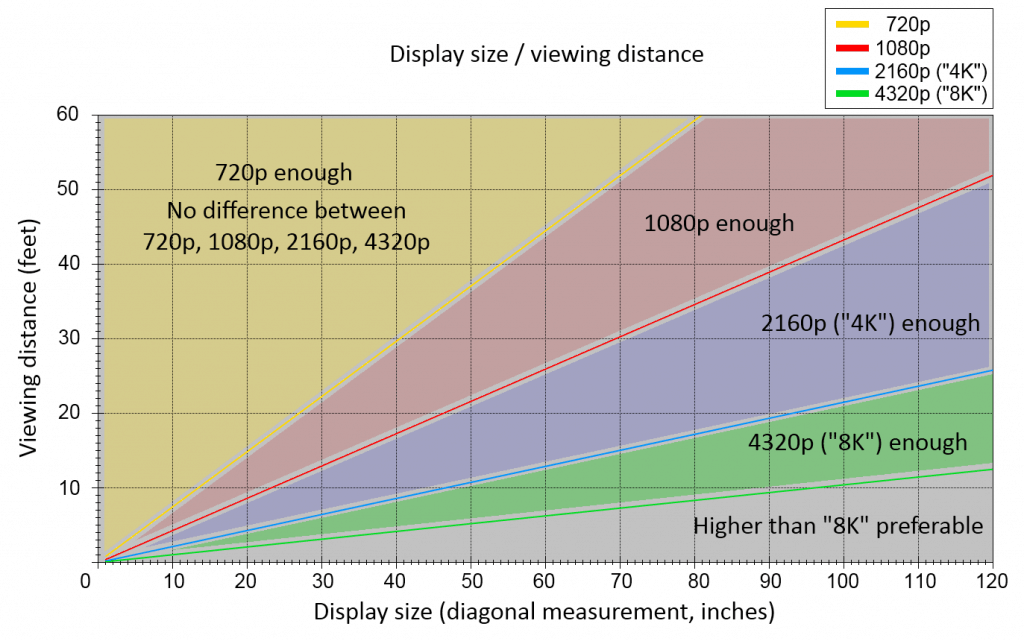
If your monitor has a sRGB mode, you'll find it among the colour temperature modes or image presets. But did you know that sRGB mode is available on some normal gamut screens? They are also capable of producing the most accurate colours.
So, what exactly does sRGB mode do? When you enable the sRGB mode, your monitor's native gamut is converted to 100% sRGB, resulting in correct colours. The colour accuracy you get here is dependent on the factory calibration of your display.
There is a large choice of monitors available that provide quality accuracy. They do, however, restrict the brightness setting to either very low or very high. Isn't that the most vexing thing? Who would want to work on a display where he can't adjust the brightness to suit his needs?
If the brightness setting becomes too high, you must adjust the brightness to work comfortably. When it's too low, it's the same way. The colour temperature on some displays is locked in sRGB mode.
For example, if your screen has an out-of-the-box colour temperature of 7000K, sRGB mode can correct it by locking the colour channels.
When working on color-critical projects on a wide-gamut monitor with sRGB colour space, keep these two considerations in mind:
Check that your monitor's sRGB mode allows you to change the brightness.
Provides good factory calibration and a lower Delta E.
Photoshop sRGB
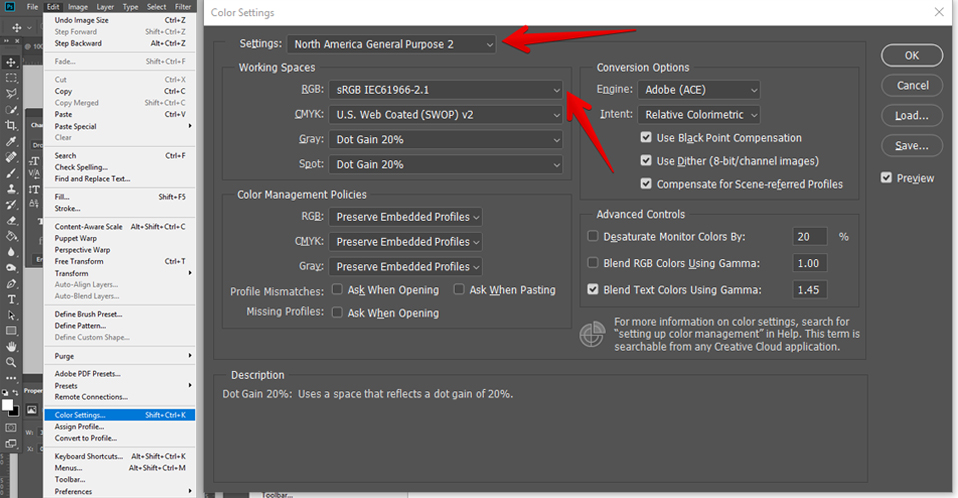
sRGB is the digital photography equivalent of a brother-in-law. You can't imagine of a precise result in digital photography without it. It is very important, especially when modifying photos with Photoshop.
For example, if you fail to modify its default option, PS will export that file with the colour changing automatically when viewed in web browsers.
Do you know why? This is because the PS workspace on Adobe systems is programmed to use the Adobe RGB colour profile by default. This option is ideal for modifying photographs that will be printed. However, in the case of web design, it can result in an incorrect hue of the design.
To resolve the issue, modify the default configuration on the PS workspace before beginning any tasks. If it matches the profile of your monitors, you won't have too many issues. Using a sRGB monitor will also provide you with the most accurate colours.
Photoshop's Adobe RGB colour space
If you plan on printing photographs or designs, Adobe RGB colour space may not be the best option. It will allow you to see the image you shot exactly as it is, giving you the largest colour spectrum imaginable. Isn't that a nice thing?
Yes, but the major disadvantage here is that you'd have to transform the image to sRGB colour space before sharing it on the web.
Going through this extra step may not be a big deal if you want to take advantage of sRGB's larger colour space. But why would you bother with such extraneous processes when you have sRGB mode? As a result, it is preferable to work solely in sRGB.
Adobe RGB vs. sRGB
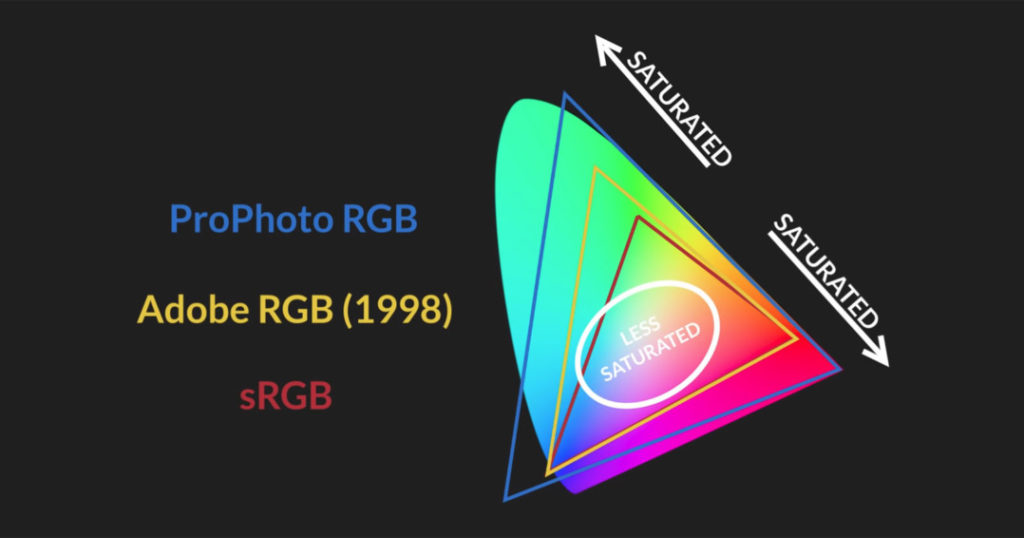
Adobe RGB and sRGB are the two most common colour spaces to employ while working on digital photography, cinematography, or graphics design.
Still unsure about the difference between the two? Rejoice, because we'll be seeing a head-to-head duel between Adobe RGB and sRGB. Let's get started.
sRGB's Advantages and Disadvantages
Without a question, sRGB is the most used colour space on the planet. When it comes to showing images online, sRGB has become the industry standard.
Most devices, browsers, and programmes, as you may know, are intended to function with the sRGB colour space. Let's have a look at the advantages and disadvantages of this so-called optimal colour space -
Pros
- The ability to dependably show content on any type of device or programme.
- Workflow is simple and easy to use.
- Compatible with standard printers.
Cons
- Colors are not as diverse as in Adobe RGB.
- Can't produce as exact colours as RGB.
- Adobe RGB's Advantages and Disadvantages
Adobe RGB provides a wide spectrum of colours but not the highest level of precision. You can use this instead of sRGB for image editing or graphic design because it has a much wider colour spectrum. Let's have a look at its advantages and disadvantages -
Pros
- Provides a substantially broader spectrum of colours than the sRGB colour space.
- Works well on quality printouts.
- Provides breathtaking image acquisition results.
- Excellent performance in identifying little colour differences.
Cons
- Most browsers are unable to show it correctly.
- Unless you are a professional, it is difficult to work with.
Questions and Answers
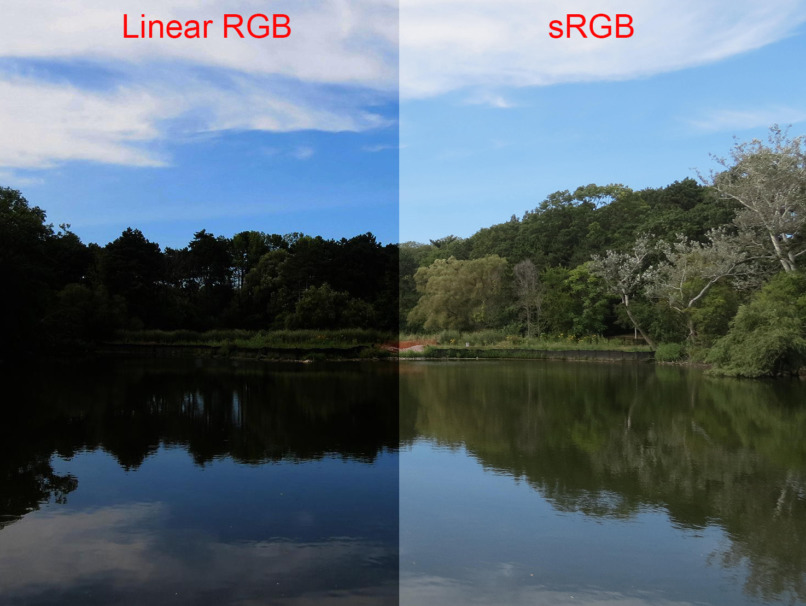
1. What is the purpose of sRGB Emulation Mode?
The sRGB emulation mode offers a wide colour spectrum. It provides a wider variety of colour space than conventional 100 percent accurate sRGB colour coverage.
As a result, the colour is more intense and exposed than in RGB mode. Red appears to be redder, blue appears to be bluer, and greens appear to be greener.
2. Do LCD monitors support sRGB colour space?
You'd be astonished to learn that most LCD displays can display all of the colours in the sRGB spectrum. As a result, YES, they can.
3. Is a sRGB Color Gamut Required for Everyday Use?
No, not at all. When you accomplish sRGB emulation mode, the colour becomes more intense than necessary. And it isn't necessary if you are a frequent user. Even in some situations, it may become irritating and irritate the human eye.
4. Can AMD GPUs Help with sRGB Emulation Mode?
It may be simpler if you have an AMD graphics card. You may enable sRGB emulation mode in your GPU driver by setting the "Custom Color" option and disabling the "Color Temperature Control."
5. Is the Adobe RGB Color Space superior to the sRGB Color Space?
To be honest, sRGB space is the best option you've had thus far. It enables photographers to examine and edit their photographs in the most accurate colour possible.
It also produces greater outcomes and more vibrant hues. In comparison, if you aren't an expert, RGB colour space might be challenging.
Final Thoughts
If you've read this far, you've probably figured out what sRGB emulation mode is and why it's significant. That's fantastic! Now, listen up: sRGB emulation modes aren't like running out of oxygen.
You won't need the sRGB emulation mode if you have a broad colour gamut screen with 90-95 DCI p3 coverage. Yes, you will get a bit more colour vibrancy with it, but it is not required.
If you have a monitor with a broader colour gamut, you'll need to use the sRGB emulation mode to combat the over-saturation. It is better to choose a monitor with good factory calibration. However, colorimeters are not required for entry-level displays.



